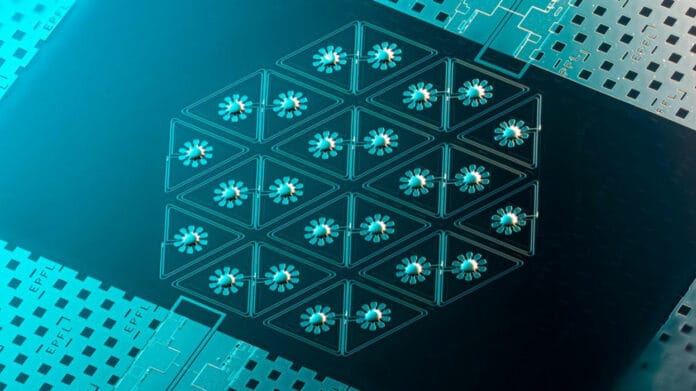Cavity optomechanics enables the control of mechanical motion through the radiation-pressure interaction and has contributed to the quantum control of engineered mechanical systems ranging from kilogram-scale Laser Interferometer Gravitational-wave Observatory (LIGO) mirrors to nanomechanical systems. Yet nearly all previous schemes have used single- or few-mode optomechanical systems.
Leading theoretical research has projected that optomechanical lattices can access substantially more complex physics and unique dynamics, such as quantum collective dynamics and topological phenomena. However, creating optomechanical lattices that can support numerous coupled optical and mechanical degrees of freedom and duplicating such devices experimentally under tight control has proven difficult.
The first large-scale and reconfigurable superconducting circuit optomechanical lattice that can solve the scaling issues of quantum optomechanical systems has been created by scientists in the laboratory of Tobias J. Kippenberg at EPFL’s School of Basic Sciences. The team realized an optomechanically strained graphene lattice and used cutting-edge measuring methods to examine non-trivial topological edge states.
A “vacuum-gap drumhead capacitor,” also a critical component of the single site of the lattice, is comprised of a thin aluminum film hung over a trench in a silicon substrate. This makes up the device’s vibrating component and simultaneously creates a resonant microwave circuit with a spiral inductor.
Amir Youssefi, who led the project, said, “We developed a novel nanofabrication technique for superconducting circuit optomechanical systems with high reproducibility and extremely tight tolerances on the parameters of the individual devices. This enables us to make the different sites virtually identical, like in a natural lattice.”
It is well known that the graphene lattice displays non-trivial topological characteristics and localized edge states. These states were seen in what the scientists refer to as a “optomechanical graphene flake” made up of twenty-four spots.
Andrea Bancora, who contributed to the research, said, “Thanks to the built-in optomechanical toolkit, we could directly and non-perturbatively image the collective electromagnetic mode shapes in such lattices. This is a unique feature of this platform.”
Their new platform offers a trustworthy testbed for researching topological physics in one and two-dimensional lattices, as demonstrated by the team’s results, which closely match the theoretical predictions.
Shingo Kono, another member of the research team, said, “By having access to both the energy levels and mode shapes of these collective excitations, we were able to reconstruct the full underlying Hamiltonian of the system, allowing for the full extraction of disorder and coupling strengths in a superconducting lattice for the first time.”
Journal Reference:
- Youssefi, A., Kono, S., Bancora, A. et al. Topological lattices realized in superconducting circuit optomechanics. Nature 612, 666–672 (2022). DOI: 10.1038/s41586-022-05367-9
